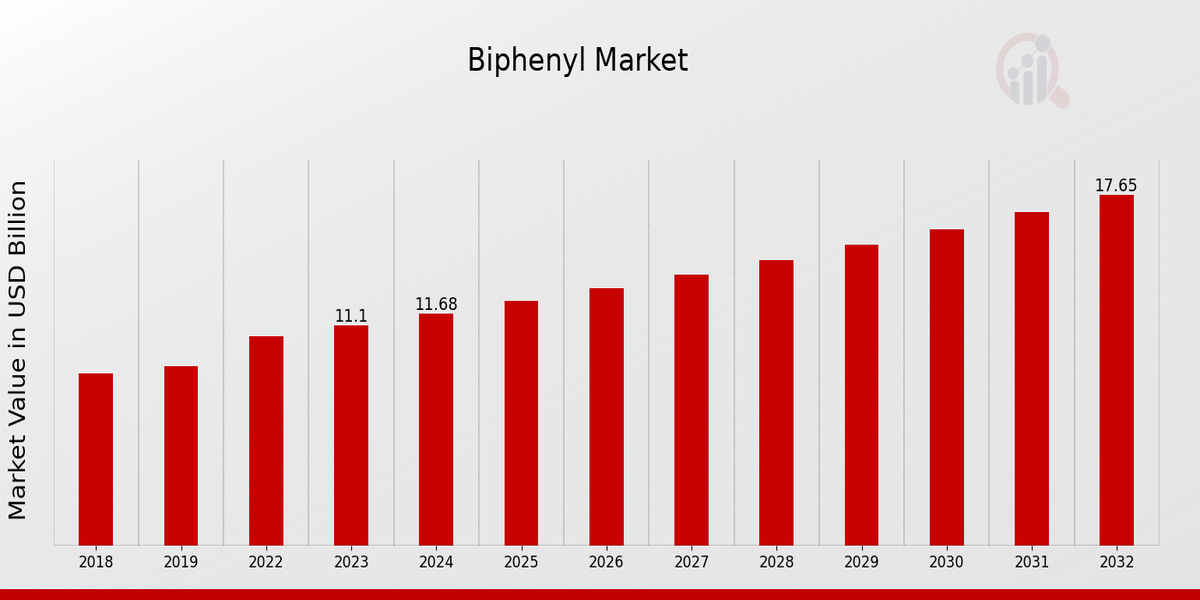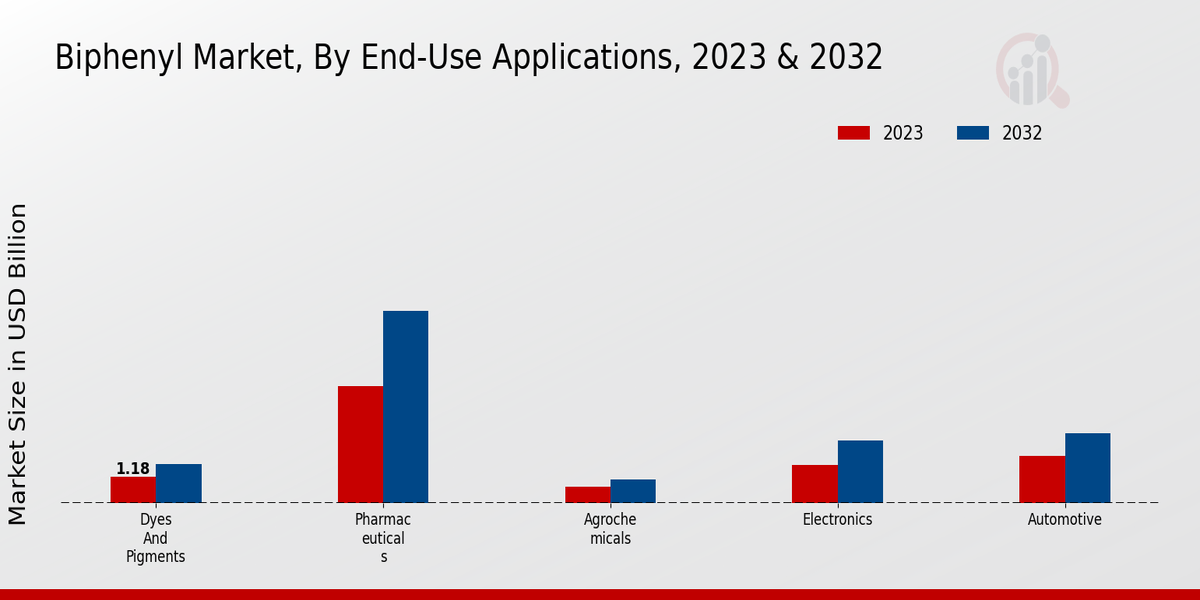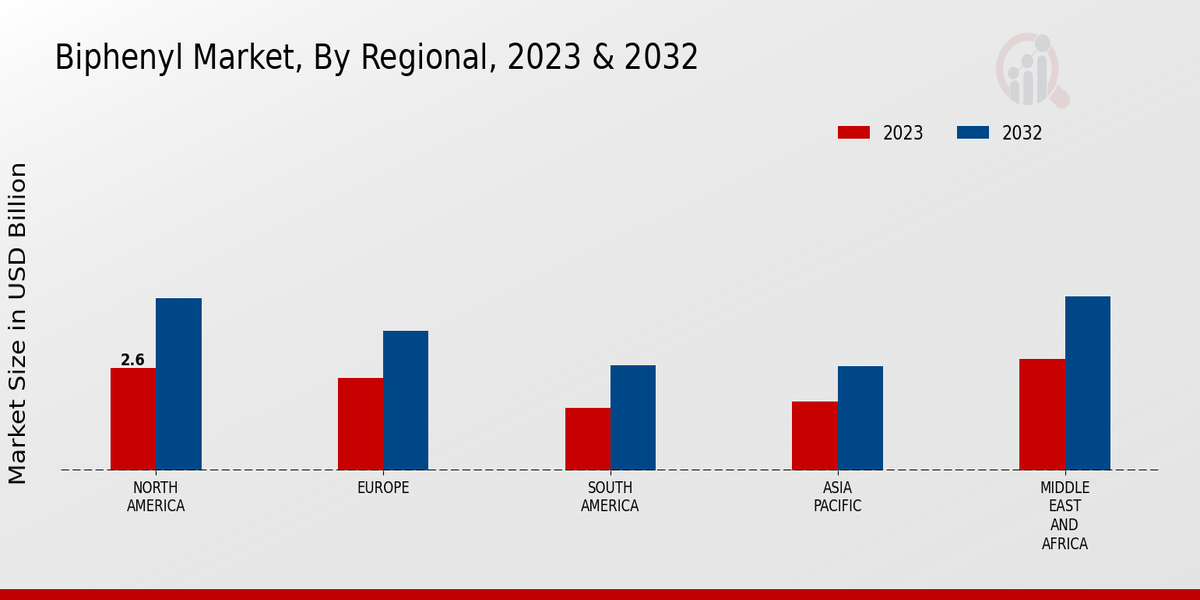Global Biphenyl Market Overview
The Biphenyl Market Size was estimated at 12.30 (USD Billion) in 2024. The Biphenyl Industry is expected to grow from 12.95 (USD Billion) in 2025 to 20.61 (USD Billion) by 2034. The Biphenyl Market CAGR (growth rate) is expected to be around 5.3% during the forecast period (2025 - 2034).
Key Biphenyl Market Trends Highlighted
Biphenyl market trends indicate increasing demand for high-purity biphenyl in electronics, particularly for use in liquid crystal displays (LCDs). The growing popularity of advanced display technologies, such as OLEDs and micro-LEDs, is also driving demand for biphenyl as an intermediate material.Emerging applications in the healthcare sector, including its use in antiseptics, disinfectants and pharmaceuticals, present opportunities for market growth. Additionally, the development of bio-based biphenyl production methods aligns with the growing emphasis on sustainability in the chemical industry.Recent market trends include the emergence of regional production hubs in Asia-Pacific and Middle East, driven by favorable manufacturing costs and access to raw materials. Partnerships and collaborations between industry players are fostering innovation and driving technological advancements in biphenyl production and applications.

Source: Primary Research, Secondary Research, MRFR Database and Analyst Review
Biphenyl Market Drivers
Increasing Demand for Biphenyl in the Electronics Industry
Biphenyl is a crucial compound used in the production of printed circuit boards, which are used in almost every electronic device available. While the demand and production of electronics, especially in emerging markets, are increasing, they require more PCBs, which, in turn, drives demand for biphenyl. Therefore, the Biphenyl Market Industry would notice a substantial rise in demand, thanks to the demand for PCBs in the electronics sector.
Growing Use of Biphenyl in the Pharmaceutical Industry
Biphenyl is also used in manufacturing a wide range of pharmaceuticals, such as antibiotics, anti-inflammatory and anti-cancer drugs. The chronic disease prevalence is increasing and there is a rise in need for novel and efficient treatments, which is projected to increase the growth of the pharmaceutical industry. In return, it will increase the demand for biphenyl.
Expanding Applications of Biphenyl in the Chemical Industry
Biphenyl is used in the production of a variety of chemicals, including dyes, pigments and plastics. The growing demand for these chemicals in various industries, such as automotive, construction and packaging, is expected to drive the demand for biphenyl.
Biphenyl Market Segment Insights:
Biphenyl Market End-Use Applications Insights
The Biphenyl Market is segmented into various end-use applications, including Dyes and Pigments, Pharmaceuticals, Agrochemicals, Electronics and Automotive. Each segment exhibits unique characteristics and growth dynamics, contributing to the overall market performance. Dyes and Pigments: The Dyes and Pigments segment accounted for a significant share of the Biphenyl Market revenue in 2023 and is projected to maintain its dominance throughout the forecast period. Biphenyl is widely used as an intermediate in the production of various dyes and pigments, owing to its excellent colorfastness and resistance to fading.The growing demand for textiles, plastics, and other consumer products is expected to drive the growth of this segment. Pharmaceuticals: The Pharmaceuticals segment is another key end-use application of Biphenyl. Biphenyl derivatives are employed as active pharmaceutical ingredients (APIs) in the manufacturing of drugs for treating neurological disorders, cardiovascular diseases and other therapeutic areas. The increasing prevalence of chronic diseases and the rising demand for innovative drug therapies are expected to contribute to the segment's growth.Agrochemicals: The Agrochemicals segment is witnessing steady growth due to the increasing use of Biphenyl in the production of pesticides and herbicides. Biphenyl-based compounds exhibit effective insect and pest control properties, making them essential for crop protection. The growing demand for agricultural productivity and the need for sustainable farming practices are driving the growth of this segment. Electronics: In the Electronics segment, Biphenyl finds applications in the production of electronic devices, particularly in printed circuit boards (PCBs) and semiconductors.Its excellent electrical insulation properties and thermal stability make it a suitable material for use in electronic components. The increasing adoption of advanced electronic devices and the growth of the semiconductor industry are expected to drive the demand for Biphenyl in this segment. Automotive: The Automotive segment is expected to witness moderate growth over the forecast period. Biphenyl is used in the production of automotive parts, such as tires, hoses and interior components, due to its resistance to chemicals and weathering. The growing production of automobiles and the increasing demand for durable and lightweight materials are expected to drive the demand for Biphenyl in this segment.Overall, the Biphenyl Market is poised for steady growth in the coming years, driven by the increasing demand from end-use applications such as Dyes and Pigments, Pharmaceuticals, Agrochemicals, Electronics and Automotive. The market's growth is supported by factors such as rising industrialization, technological advancements, and increasing disposable income levels.

Source: Primary Research, Secondary Research, MRFR Database and Analyst Review
Biphenyl Market Purity Grade Insights
The Biphenyl Market is segmented by Purity Grade into Reagent Grade, Industrial Grade, and Technical Grade. Among these, the Reagent Grade segment held the largest market share in 2023, accounting for around 45% of the Biphenyl Market revenue. The Industrial Grade segment is expected to witness the highest market growth over the forecast period, owing to the increasing demand from the chemical and pharmaceutical industries. The Technical Grade segment is expected to hold a significant market share over the forecast period due to its wide applications in the production of dyes, pigments and rubber chemicals.
Biphenyl Market Market Participants Insights
The Biphenyl Market is segmented into manufacturers, distributors and end-users. The manufacturers segment is expected to account for the largest share of the market in 2023, with a market value of 11.1 USD Billion. The end-users segment is expected to grow at a moderate pace during the forecast period, driven by increasing demand from various industries.
Biphenyl Market Production Process Insights
The Biphenyl Market is segmented by Production Process into Traditional Process, Ullmann Process and Benzene Oxidation Process. Among these, the Traditional Process segment held the largest market share in 2023, accounting for around 45% of the Biphenyl Market revenue. The Ullmann Process segment is expected to grow at the highest CAGR during the forecast period, owing to its advantages, such as lower energy consumption and higher efficiency. The Benzene Oxidation Process segment is also expected to witness significant growth, driven by the increasing demand for biphenyl in the production of polyphenylene oxide resins.
Biphenyl Market Packaging Type Insights
The packaging type segment of the Biphenyl Market is expected to grow significantly in the coming years. Drums offer several advantages, including durability, ease of handling and cost-effectiveness. Barrels, on the other hand, are expected to witness a moderate growth rate, reaching a valuation of USD 2.3 billion by 2032. Tanks and totes are also projected to contribute to the overall market growth, with tanks expected to reach a value of USD 3.4 billion and totes projected to reach USD 1.7 billion by 2032. The growth of the packaging type segment is primarily driven by the increasing demand for biphenyl in various end-use industries, such as plastics, rubber and pharmaceuticals.
Biphenyl Market Regional Insights
The regional segmentation of the Biphenyl Market presents diverse growth dynamics across key geographic regions. North America is projected to hold a significant market share, driven by the presence of established chemical and pharmaceutical industries. The region is expected to witness steady growth over the forecast period, with increasing demand from various end-use sectors. Europe is another prominent market characterized by stringent environmental regulations and a focus on sustainable practices. The region is anticipated to exhibit moderate growth, driven by the adoption of bio-based biphenyl in various applications.APAC is anticipated to emerge as a lucrative market, primarily due to the expanding chemical and electronics industries in countries like China and India. The region is poised for significant growth, supported by increasing urbanization and industrialization. South America and MEA represent emerging markets with untapped potential. While the current market share is relatively small, these regions are expected to experience substantial growth in the coming years, driven by rising demand from the construction and automotive industries.

Source: Primary Research, Secondary Research, MRFR Database and Analyst Review
Biphenyl Market Key Players And Competitive Insights:
Major players in Biphenyl Market industry continue to innovate and invest in product development, leading to the introduction of new and improved solutions. Key industry players are focusing on expanding their global presence, acquiring competitors, and establishing partnerships and joint ventures to gain a competitive edge. Collaboration between market leaders and emerging companies is shaping the Biphenyl Market development landscape. Leading Biphenyl Market players are actively engaged in research and development to enhance product performance and meet evolving customer needs. Technological advancements, such as the integration of digital technologies and artificial intelligence, are expected to drive market growth in the coming years.Ajinomoto Fine-Techno Co., Ltd. is a leading company in the Biphenyl Market industry, specializing in the production and supply of high-quality biphenyl products. The company's strong commitment to quality, innovation, and customer satisfaction has enabled it to establish a solid reputation in the market. Ajinomoto Fine-Techno Co., Ltd. has a global presence with manufacturing facilities in Japan, China, and the United States. The company's product portfolio includes a wide range of biphenyl derivatives, including biphenyl, 4,4'-dibromobiphenyl, and 2,2',4,4'-tetrabromobiphenyl. Ajinomoto Fine-Techno Co., Ltd. serves a diverse customer base across various industries, including pharmaceuticals, electronics, and chemicals.Mitsui Chemicals, Inc. is a key competitor in the Biphenyl Market industry, recognized for its advanced manufacturing capabilities and extensive product portfolio. The company leverages its expertise in chemical synthesis and processing to produce high-purity biphenyl products. Mitsui Chemicals, Inc. has a strong focus on research and development and continuously invests in innovative technologies to meet the evolving needs of its customers. The company's global reach allows it to cater to customers in various regions. Its commitment to sustainability and environmental responsibility makes Mitsui Chemicals, Inc. a preferred choice for many customers.
Key Companies in the Biphenyl Market Include:
- Shanghai Yuanye Chemical
- Hangzhou Yuxin Chemical
- Merck
- Jiangsu Yangnong Chemical
- Shandong Jinyu Bioengineering
- Clariant
- Anqiu Luhua Fine Chemical
- Shanghai Kaixiang Chemical Technology
- Lanxess
- Zhejiang Pharmaceutical
- BASF
- Shandong Longlive Pharmaceutical
- Shanghai Lianheng New Material Technology
- Sun Pharmaceutical Industries
- Zhejiang Jiuzhou Pharmaceutical
Biphenyl Market Industry Developments
The market growth is primarily driven by the increasing demand for biphenyl in the production of polychlorinated biphenyls (PCBs), which are used in various industrial applications such as electrical insulation, heat transfer fluids, and flame retardants. However, environmental concerns and regulations restricting the use of PCBs are expected to restrain market growth to some extent.Recent developments in the Biphenyl Market include the launch of new products and technologies by key players. For instance, in 2023, LANXESS introduced a new grade of biphenyl, Lewacol P 100, which is specifically designed for use in the production of high-performance polyphenylene ethers (PPEs). Additionally, the growing adoption of biphenyl in the production of advanced materials, such as carbon fiber-reinforced plastics (CFRPs), is expected to create new growth opportunities for the market in the coming years.
Biphenyl Market Segmentation Insights
- Biphenyl Market End-Use Applications Outlook
- Dyes and Pigments
- Pharmaceuticals
- Agrochemicals
- Electronics
- Automotive
- Biphenyl Market Purity Grade Outlook
- Reagent Grade
- Industrial Grade
- Technical Grade
- Biphenyl Market Market Participants Outlook
- Manufacturers
- Distributors
- End-Users
- Biphenyl Market Production Process Outlook
- Traditional Process
- Ullmann Process
- Benzene Oxidation Process
- Biphenyl Market Packaging Type Outlook
- Drums
- Barrels
- Tanks
- Totes
- Biphenyl Market Regional Outlook
- North America
- Europe
- South America
- Asia Pacific
- Middle East and Africa
| Report Attribute/Metric |
Details |
| Market Size 2024 |
12.30 (USD Billion) |
| Market Size 2025 |
12.95 (USD Billion) |
| Market Size 2034 |
20.61 (USD Billion) |
| Compound Annual Growth Rate (CAGR) |
5.3% (2025 - 2034) |
| Report Coverage |
Revenue Forecast, Competitive Landscape, Growth Factors, and Trends |
| Base Year |
2024 |
| Market Forecast Period |
2025 - 2034 |
| Historical Data |
2020 - 2024 |
| Market Forecast Units |
USD Billion |
| Key Companies Profiled |
Shanghai Yuanye Chemical, Hangzhou Yuxin Chemical, Merck, Jiangsu Yangnong Chemical, Shandong Jinyu Bioengineering, Clariant, Anqiu Luhua Fine Chemical, Shanghai Kaixiang Chemical Technology, Lanxess, Zhejiang Pharmaceutical, BASF, Shandong Longlive Pharmaceutical, Shanghai Lianheng New Material Technology, Sun Pharmaceutical Industries, Zhejiang Jiuzhou Pharmaceutical |
| Segments Covered |
End-Use Applications, Purity Grade, Market Participants, Production Process, Packaging Type, Regional |
| Key Market Opportunities |
Biobased biphenyl production Demand from electronics industry Growing use in agrochemicals Applications in high-performance materials Increasing demand from emerging economies. |
| Key Market Dynamics |
Rising demand for resins growing electronics industry, increasing use in pharmaceuticals. |
| Countries Covered |
North America, Europe, APAC, South America, MEA |
Frequently Asked Questions (FAQ) :
The Biphenyl Market is anticipated to reach a valuation of approximately 12.95 billion USD in 2025.
The Biphenyl Market is projected to expand at a CAGR of 5.3% from 2025 to 2034.
By 2034, the Biphenyl Market is anticipated to reach a valuation of around 20.61 billion USD.
The Asia-Pacific region is projected to hold the dominant position in the Biphenyl Market throughout the forecast period.
The rising demand for Biphenyl in various applications, such as pharmaceuticals, electronic materials, and plastics, is a primary growth driver for the market.
Some of the prominent players in the Biphenyl Market include companies like Lanxess, Sumitomo Chemical, and INEOS.
Biphenyl finds applications in the production of pharmaceuticals, electronic materials, plastics, and rubber chemicals.
The pharmaceutical industry represents a significant consumer of Biphenyl for the manufacturing of various drug intermediates.
Government regulations related to the production and usage of Biphenyl, particularly in the context of environmental protection, can influence the market dynamics.
The market is anticipated to witness continued growth, driven by factors such as technological advancements and increasing demand from emerging economies.

















